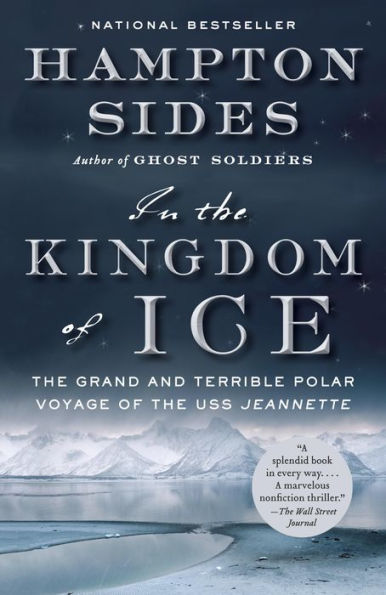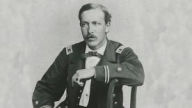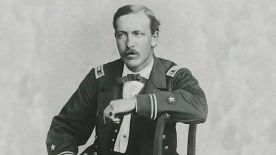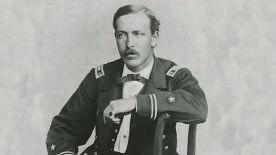Read an Excerpt
Prologue : Baptism by Ice
On a misty morning in late April 1873, the Tigress, a steam barkentine out of Conception Bay, Newfoundland, was pushing through the loose floes and bergs off the coast of Labrador, heading for the seasonal seal-hunting grounds. Late in the morning, the Tigress encountered something strange: A lone Inuit in a kayak was hailing the ship, waving his arms and screaming at the top of his lungs. The native man was clearly in some kind of trouble. He had ventured much farther out into the perilous open waters of the North Atlantic than any Eskimo ordinarily would. When the Tigress pulled closer to him, he yelled, in accented English, “American steamer! American steamer!”
The crew of the Tigress leaned over the railings and tried to decipher what the Inuit was talking about. Just then, the fog parted enough to reveal, in the middle distance, a jagged floe piece, on which more than a dozen men and women, plus several children, appeared to be trapped. Seeing the ship, the marooned party erupted in cheers and fired guns into the air.
The Tigress’s captain, Isaac Bartlett, ordered rescue boats put in the water. When the stranded people—nineteen in all—were brought aboard, it was immediately apparent that they had suffered a horrific ordeal. Emaciated, filthy, and frostbitten, they had haunted looks in their eyes. Their lips and teeth were greasy from a just-finished break- fast of seal intestine.
“How long have you been on the ice?” Captain Bartlett asked them.
The senior member of the group, an American named George Tyson, stepped forward. “Since the fifteenth of October,” he replied.
Bartlett tried to understand what Tyson was saying. October
15 was 196 days earlier. These people, whoever they were, had been stranded on this ice slab for nearly seven months. Their precarious floe had been, Tyson said, a “God-made raft.”
Bartlett questioned Tyson further and learned, to his astonish- ment, that these pitiful castaways had been aboard the Polaris, a ship famous around the world. (This was the “American steamer!” the Inuit had been screaming about.) The Polaris, an unprepossessing steam tug that had been reinforced for the ice, was the exploring ves- sel of an American polar expedition, partly funded by Congress and supported by the U.S. Navy, that had left New London, Connecticut, two years earlier and, after a few stops along the way to Greenland, had not been heard from since.
A FTER PENETR ATING JUST beyond the 82nd parallel, a nautical latitude record at the time, the Polaris had become trapped in the ice high along the west coast of Greenland. Then, in November 1871, the expedition commander, a brooding, eccentric visionary from Cincin- nati named Charles Francis Hall, had died under mysterious circum- stances after drinking a cup of coffee that, he suspected, had been laced with poison. Following Hall’s death, the leaderless expedition had completely unraveled.
On the night of October 15, 1872, a large piece of ice on which Tyson and eighteen other expedition members were temporarily encamped had suddenly broken away from the vicinity of the ship and started drifting into Baffin Bay. The party of castaways, which included several Inuit families and a newborn infant, was never able to rejoin the Polaris, and they resigned themselves to their slab of ice. They helplessly floated toward the south, through the winter and spring, sleeping in igloos and living on seals, narwhals, seabirds, and the occasional polar bear. Not having any fuel with which to cook, they ate only raw meat, organs, and blood, when they were lucky enough to have it, for the duration of their drift.
Tyson said they had been “fools of fortune.” Huddled miserably on their ever-shrinking slab, they were batted around “like a shuttle-cock,” he said, by heaving seas, crashing icebergs, and powerful gales. Amazingly, though, no one in the stranded party had died. In all, they had drifted eighteen hundred miles.
Dumbfounded by Tyson’s story, Captain Bartlett welcomed the unfortunates to his ship, fed them a warm meal of codfish, potatoes, and coffee, and in due course delivered them to St. John’s, Newfound- land, where they were met by a U.S. Navy vessel and taken straight to Washington. A hasty interrogation of Tyson and other survivors revealed, among other things, that the Polaris, though damaged, was likely still intact and that the balance of the expedition—fourteen members—might yet be alive, trapped on their leaky ship somewhere high in the Greenland ice. Naval authorities, after cross-examining the survivors, learned that the Polaris had suffered a crisis of leader- ship nearly from the start, that mutiny had been discussed, and that Charles Hall may indeed have been poisoned. (Nearly a century later, forensic experts exhumed his corpse and detected toxic quantities of arsenic in tissue samples.) Tyson, though refusing to name names, cried foul. “Those who have baffled and spoiled this expedition,” he roared, “cannot escape their God!”
The American public, stunned by this woeful tale of a national voyage gone spectacularly wrong, clamored for a relief expedition to return to the Arctic to hunt for survivors. And so, with President Ulysses S. Grant’s approval, the Navy promptly dispatched a ship, the USS Juniata, to Greenland to commence a search for the hobbled Polaris.
The Juniata, under the command of Daniel L. Braine, was a battle-scabbed sloop of war that had seen much action in the Atlantic blockade during the Civil War. Newspapers across America celebrated her departure from New York on June 23. The Juniata’s mission to Greenland had all the elements: Here was a thrilling rescue story of national import—and also a detective story, with a whiff of intrigue and possible murder. A correspondent from the New York Herald would be joining the Juniata at St. John’s to report on the search. In large part because of the Herald ’s presence, the hunt for the Polaris would become the sensation of the late summer of 1873.
THE SECOND-IN-COMMAND A BOARD the Juniata was a young lieutenant from New York City named George De Long. Twenty- eight years old, his keen blue-gray eyes framed by pince-nez glasses, De Long was a man in a hurry to do great things. He was large and broad-shouldered and weighed 195 pounds. A graduate of the U.S. Naval Academy, ginger-haired and fair-skinned, he had a shaggy mustache that drooped prodigiously over the corner creases of his mouth. Whenever he had a moment to sit, he could usually be found smoking a meerschaum pipe, his head buried in a book. The warmth of his smile and the softness of his fleshy face were offset by a certain truculence in his jawline, a feature observers often remarked upon. De Long was a determined, straight-ahead sort of man, efficient and thorough, and he burned with ambition. One of his expressions, a motto of sorts, was “Do it now.”
De Long had sailed over much of the world—Europe, the Carib- bean, South America, and all along the Eastern Seaboard—but he had never been to the Arctic before, and he was not especially look- ing forward to the journey. De Long was far more accustomed to the tropics. He had never paid attention to the great quest for the North Pole, which had so ferociously preoccupied explorers like Hall and thrilled the public. To De Long, the Juniata’s cruise to Greenland was just another assignment.
He did not seem to think much of St. John’s, where the Juniata stopped to take on stores and where shipbuilders sheathed her bow in iron for the coming encounters with the ice. When the Juniata reached the half-frozen hamlet of Sukkertoppen, on Greenland’s southwestern coast, De Long wrote to his wife, “I never in my life saw such a dreary land of desolation and I hope I may never find myself cast away in such a perfectly God-forsaken place . . . The ‘town,’ such as it is, consists of two houses and about a dozen huts made of mud and wood. I went into one and have been scratching ever since.”
De Long was positively smitten with his wife, Emma, a young French-American woman from Le Havre. He hated being so far away from her. He and Emma had been married for more than two years but had scarcely seen each other, for De Long’s Navy assignments had kept him almost constantly at sea. Sylvie, their baby girl, was nearly a stranger to him. The De Longs had a little apartment on Twenty-second Street in Manhattan, yet he was never there. Emma said her husband was a man “destined always to be separated from the ones he loved.” There was not much he could do about his prolonged absences—this was the life of a career naval officer.
At times, though, De Long dreamed of taking a leave and liv- ing another kind of existence with Emma and Sylvie, somewhere in the American West, or in the countryside in the south of France. From Greenland, he wrote to Emma about his fantasy. “I cannot help thinking how much happier we should be if we were together,” he said. “When we are apart I devise so many schemes . . . How nice it would be to go to some quiet place in Europe and pass a year by ourselves, where the Navy Department would not bother me with its orders, or any troubles come to make us uneasy. I think, darling, when I finish this cruise I might be able to get a year’s absence and we might spend it together where it would not be expensive and have a little home of our own. Don’t you think we could do that?”
De Long’s disdain for the polar landscape soon wore off. As the Juniata crossed the Arctic Circle and pressed ever farther up the ragged west coast of the world’s largest island, something began to take hold of him. He became more and more intrigued by the Arc- tic, by its lonely grandeur, by its mirages and strange tricks of light, its mock moons and blood-red halos, its thick, misty atmospheres, which altered and magnified sounds, leaving the impression that one was living under a dome. He felt as though he were breathing rarefied air. He became intrigued by the phenomenon of the “ice blink,” the spectral glow in the low sky that indicated the presence of a large frozen pack ahead. The scenery grew more impressive: ice-gouged fjords, towering bergs calved fresh from glaciers, the crisp sound of cold surf lapping against the pack, ringed seals peeking through gaps in the ice, bowhead whales spouting in the deep gray channel. This was the purest wilderness De Long had ever seen, and he began to fall in love with it.
BY L ATE JU LY, when the Juniata arrived at Disko Island, a wind- swept place of bubbling hot springs and Viking legends far up the coast of Greenland, De Long’s baptism by ice was nearly complete. Dressed head to toe in furs and wearing sealskin boots, he had gotten into the swing of things. “We have taken on board twelve dogs for sleds,” he wrote, “and we are now really worth looking at. The ship is black with dirt and coal dust, dogs packed away among the coal, sheep tied up forward and beef hanging around right and left with fish here and there. We are really in a good state to go anywhere.”
As he continued northward, De Long found himself absorbed by the question of what had happened to Charles Francis Hall and his expedition. Where had it gone wrong? What decisions had led to its demise? Where was the Polaris now, and were there any survivors? As a Navy officer, he was intrigued by matters of hierarchy, disci- pline, and motivation—how an operation was organized, and how that organization might fall apart. De Long felt himself being pulled deeper into a mystery infinitely more interesting than the dreary duties of his ordinary life at sea.
On July 31, the Juniata arrived at the tiny ice-clogged village of Upernavik, four hundred miles above the Arctic Circle, and here the plot of this polar detective story began to thicken. De Long and Cap- tain Braine went ashore to meet with a Danish official named Krarup Smith, the inspector royal of North Greenland. Inspector Smith had some interesting things to say about Charles Hall, who had stopped here with his entire expedition two years earlier, before disappearing in the High Arctic. Smith did not know where the Polaris was now, or whether there were any survivors, but he did offer one intriguing detail: Hall, he said, had had a presentiment of his own death.
When he arrived in Upernavik, Hall hinted that there was dissen- sion in the ranks, that some of the men were plotting to remove him from command. He sensed that he would never make it home, that he would die in the Arctic. Hall felt so sure of this that, for safekeeping, he left a bundle of valuable papers and other artifacts with Inspector Smith.
The reporter for the New York Herald, Martin Maher, noted that Smith “narrated with considerable minuteness the details of a quar- rel” in which certain members of the expedition “endeavored to preju- dice the crew of the ship against” Hall.
To hear Smith tell it now, the Hall expedition had been doomed before it even ventured into the ice. “The officers and crew of the Polaris were utterly demoralized,” Maher reported, and “Captain Hall evidently had some kind of misgiving or premonition of death.”
UPERNAVIK WAS AS far north as Captain Braine felt comfortable taking the Juniata. Despite her iron sheathing, she was not really designed or equipped to handle significant quantities of ice. The ship did, however, have a smaller boat, dubbed the Little Juniata, that was more agile, capable of navigating through the confusion of bergs and floes. Rigged as a sloop, the twenty-eight-foot launch carried a small steam engine, which powered a three-bladed screw propeller. Braine wanted a half dozen of his men to take the Little Juniata and continue the search for another four hundred miles along the fjord-riddled coast, up to a place called Cape York.
This secondary probe, which Braine estimated would take several weeks, was a dubious undertaking at best. The Little Juniata seemed a frightfully vulnerable craft, not much more than an open boat. Ice fields like these had crushed entire whaling fleets. Braine knew he could not order anyone to undertake this risky assignment; he had to rely on volunteers.
De Long was the first to raise his hand, and it was soon decided that he would captain the little vessel. De Long’s second-in-command would be a quiet, reliable fellow Naval Academy graduate from upstate New York named Charles Winans Chipp. Seven others cast their lot with De Long, including an Eskimo interpreter, an ice pilot, and Martin Maher from the Herald. Braine bid them farewell, not- ing in his written instructions to De Long, “I shall await with great interest your return to this ship from the hazardous duty for which you have volunteered.”
They nosed away from the Juniata on August 2, carrying provi- sions for sixty days and towing a dinghy loaded with twelve hundred pounds of coal. The little steam engine clanked away as De Long threaded through a series of fog-shrouded islands and thousands of small icebergs called growlers. They stopped at a few remote Inuit settlements—Kingitok, Tessi-Ussak—and then headed into a void, dodging massive bergs that dwarfed the boat.
Maher said he had “never witnessed a more glorious scene . . . Looking abroad on the immense fields of ice, glittering in the rays of the sun, and the thousands of huge, craggy icebergs as they sulkily floated out into Baffin’s Bay, one became awed by the dreadful maj- esty of the elements, and wondered how it would be possible to avoid being crushed to atoms.”
Eventually the Little Juniata was brought to a standstill in fields of unbroken pack, and De Long was forced repeatedly to ram the ice in order to break free, splintering the greenheart planks that reinforced the hull. They were enveloped in a dense freezing fog, and all the rig- ging became rimed in ice. “Absolutely hemmed in, we were now in a most perilous position, and sudden destruction threatened us,” wrote Maher. “We forced a passage westward at length, and after a terrific struggle of twelve hours, found open water again.”
De Long could not have been happier. He and Lieutenant Chipp were enjoying the cruise—and rising to its challenges. “Our boat is a beauty, doing everything but talking,” he wrote in a letter later mailed to Emma. “Now do not be alarmed if you do not hear from me for some time. If by any accident we should be frozen up all winter you will not hear from me again till spring. But be of good cheer. I expect to be back to the ship in fifteen days.”
Forty miles south of Cape York, De Long anchored to a large berg in order to hack away chunks of ice for the Little Juniata’s freshwater stores. A large fracture suddenly developed in an overhanging arm of the berg. Sensing danger, De Long pulled away only moments before a huge block of ice fell, smashing into the sea. This, in turn, caused the entire berg to wobble, then to upend. If De Long had been only a few feet closer, the Little Juniata would have been destroyed.
So far, De Long had not seen any sign of the Polaris, or any evi- dence of survivors; it was perhaps quixotic to think they would, given the scale of this fogbound wilderness. But as the commander inched into higher latitudes, approaching the 75th parallel, he found himself pulled into an ever-larger mystery. The complexity of the High Arctic spread before him like a riddle. He had never felt so alive, so engaged in the moment. He realized that he was becoming what the Arctic scientists liked to call a “pagophile”—a creature that is happiest in the ice.
ON AUGUST 8, the Little Juniata became enveloped in thick fog. The seas grew restive, and within a few hours she was in a full-on gale, the tiny vessel pitching in ice-chunked swells. “At every one of the fearful plunges,” De Long later wrote, “solid seas came aboard and showers of spray were thrown over, deluging everything in the boat. Our bailing made little impression.”
The storm had turned the existing ice fields into a dangerous roil, while also breaking off new slabs from surrounding icebergs and hurling them into the heaving sea. The Little Juniata was in constant peril of being ground to pieces. “Looking back at it now makes me tremble,” De Long wrote, “and I can only say that it was a miracle of Divine Providence that we were saved.” Said Martin Maher in the Herald: “The waves, lashed to a fury, burst against these mountains of ice, breaking off ponderous-looking, solid masses, which fell into the sea with a deafening sound. The destruction of the boat and all on board now seemed imminent. We were bound up in this terrible place, the appalling precipices of ice casting off their missiles of death.”
The gale raged for thirty-six hours. Somehow the Little Juniata held together, and when the storm abated, De Long was determined to resume his dash for Cape York despite the ominous fields of ice spread before him. “I was not disposed to quit without a fight,” he wrote. But he was running dangerously low on coal, and his men were miserable—freezing, hungry, soaked to the bone. He couldn’t get the boiler lit, as the kindling and tinder were thoroughly saturated. One of his men, after holding a friction match against his body for several hours, finally succeeded in lighting a candle, and soon the spluttery steam engine was coaxed back to life.
De Long smashed through the ice for a day, but he could see that continuing the journey would be beyond foolhardy. He had to consider “how far the lives of our little party were to be jeopardized,” he wrote, noting that he felt a responsibility that “I do not desire to have again.” De Long conferred with Lieutenant Chipp, whom he had come to admire for his calm sense of judgment. On August 10, Lieutenant George De Long did something he rarely ever did: He gave up. “Prosecuting the search for the Polaris people any longer was out of the question,” he said. They had ventured more than four hundred miles and had crossed the 75th parallel. But now, only eight miles from Cape York, the Little Juniata was turning around.
(Unbeknownst to De Long, all the remaining survivors of the Polaris—fourteen in total—had been picked up in June by a Scottish whaling vessel. They would eventually be taken to Dundee, Scotland, and would not return home to the United States until the fall.)
De Long steered the Little Juniata through intermittent ice fields toward the south. Running out of coal to fuel the steam engine, he was forced to improvise, burning slabs of pork in the furnace.
After a round-trip journey of more than eight hundred miles, the Little Juniata reunited with her mother ship in mid-August. Captain Braine had all but given up on the little steam launch, but now De Long was welcomed aboard the Juniata as a lost hero. “The ship was wild with excitement,” De Long wrote, “the men manning the rig- ging and cheering us. When I stepped over the side, so buried in furs as to be almost invisible, they made as much fuss over me as if I had risen from the dead, and when the Captain shook hands with me he was trembling from head to foot.”
THE JUNIATA RETURNED to St. John’s, then made its way for New York, where it arrived with much fanfare in mid-September. At the docks, De Long dodged reporters and slipped quietly away to his wife and baby daughter.
When he reunited with Emma, however, she instantly noticed a change. George had turned twenty-nine while in Greenland, but that was not it. Something was fundamentally different about him, something new in his eyes, in his demeanor. It was as though he had contracted a fever. He was already talking about returning to the Arctic. He became absorbed in Arctic literature and Arctic maps. He submitted his name for the next Navy expedition that might head for the High North.
“The adventure had affected him deeply and would not let him rest,” Emma wrote. She began to suspect that their sabbatical in the French countryside, the one he had dreamed about while in Green- land, would never come to pass. “The polar virus was in George’s blood to stay.”
The essential question, the one that had animated Charles Hall and other explorers before him, had begun to pull at De Long: How would man reach the North Pole? And once there, what would it be like? Were there open sea routes? Unknown species of fish and ani- mals? Monsters that lived on the ice? Lost civilizations, even? Were there whirlpools, as many people believed, that led to the bowels of the earth? Were woolly mammoths and other prehistoric creatures still wandering the Arctic solitudes? What other natural wonders might be found along the way? Or was the pole something else altogether—a verdant land warmed by vast ocean currents?
The more he pondered the problem of the North Pole, said Emma, “the greater became his desire to give that answer which alone would satisfy the world. The Arctic had cast its spell over him and from the moment of his return to New York its great mystery fascinated him.”






